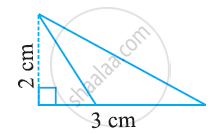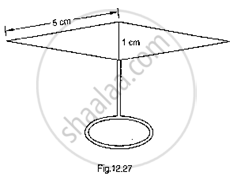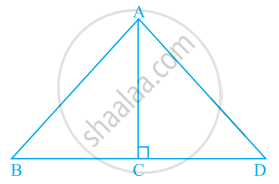Advertisements
Advertisements
प्रश्न
If area of triangle is 35 square units with vertices (2, −6), (5, 4), and (k, 4), then k is ______.
पर्याय
12
-2
−12, −2
12, −2
उत्तर
If area of triangle is 35 square units with vertices (2, −6), (5, 4), and (k, 4). Then k is 12, −2.
Explanation:
Given, the vertices of the triangle are (2, -6), (5, 4) and (k, 4);
`Delta` Area of = `Delta = 1/2 abs ((x_1,y_1,1),(x_2,y_2,1),(x_3,y_3,1))`
x1 = 2, y1 = 6, x2 = 5, y2 = 4, x3 = k, y3 = 4
`Delta` Area of `pm 35`
`pm 35 = 1/2 [2(4 - 4) + 6(5 - k) + k (120 - 4 k)`
`=> pm 35 = 1/2 [ 2 xx 0 + 6(5 - k) + 1 (20 - 4 k)]`
`=> pm 70 = 6(5 - k) + 20 - 4 k`
`=> pm 70 = 30 - 6 k + 20 - 4 k`
`=> pm 70 = 50 - 10 k`
`=> pm 70 = 5 - k`
7 = 5 - k
⇒ k = 5 - 7
k = -2
-7 = 5 - k
⇒ - 12 = - k
⇒ k = 12
अत: k = 12, -2
APPEARS IN
संबंधित प्रश्न
Find the values of k so that the area of the triangle with vertices (k + 1, 1), (4, -3) and (7, -k) is 6 sq. units.
A(4, - 6), B(3,- 2) and C(5, 2) are the vertices of a 8 ABC and AD is its median. Prove that the median AD divides Δ ABC into two triangles of equal areas.
If P(–5, –3), Q(–4, –6), R(2, –3) and S(1, 2) are the vertices of a quadrilateral PQRS, find its area.
The vertices of ∆ABC = are A (4, 6), B(1, 5) and C(7, 2). A line is drawn to intersect sides AB and AC at D and E respectively such that `\frac{AD}{AB}=\frac{AE}{AC}=\frac{1}{4}` .Calculate the area of ∆ADE and compare it with the area of ∆ABC
Prove that the points (a, b + c), (b, c + a) and (c, a + b) are collinear
For what value of k are the points (k, 2 – 2k), (–k + 1, 2k) and (–4 – k, 6 – 2k) are collinear ?
The coordinates of A, B, C are (6, 3), (–3, 5) and (4, – 2) respectively and P is any point (x, y). Show that the ratio of the areas of triangle PBC and ABC is
median of a triangle divides it into two triangles of equal areas. Verify this result for ΔABC whose vertices are A (4, - 6), B (3, - 2) and C (5, 2).
The class X students of a secondary school in Krishinagar have been allotted a rectangular plot of land for their gardening activity. Saplings of Gulmohar are planted on the boundary at a distance of 1 m from each other. There is a triangular grassy lawn in the plot as shown in the following figure. The students are to sow seeds of flowering plants on the remaining area of the plot.

(i) Taking A as origin, find the coordinates of the vertices of the triangle.
(ii) What will be the coordinates of the vertices of Δ PQR if C is the origin?
Also calculate the areas of the triangles in these cases. What do you observe?
Find values of k if area of triangle is 4 square units and vertices are (k, 0), (4, 0), (0, 2)
Find equation of line joining (1, 2) and (3, 6) using the determinant.
Find the area of the following triangle:

ΔABC is right angled at A (see the given figure). AD is perpendicular to BC. If AB = 5 cm, BC = 13 cm and AC = 12 cm, Find the area of ΔABC. Also find the length of AD.

If A(–5, 7), B(–4, –5), C(–1, –6) and D(4, 5) are the vertices of a quadrilateral, find the area of the quadrilateral ABCD
Find the area of a triangle whose vertices are
(6,3), (-3,5) and (4,2)
The vertices of ΔABC are (−2, 1), (5, 4) and (2, −3) respectively. Find the area of the triangle and the length of the altitude through A.
Find the area of a triangle whose sides are 9 cm, 12 cm and 15 cm ?
The perimeter of a triangular field is 540 m and its sides are in the ratio 25 : 17 : 12. Find the area of the triangle ?
Find the area of the blades of thc magnetic compass shown in Fig.. 12.27. (Take √11 = 3.32).

prove that the points A (7, 10), B(-2, 5) and C(3, -4) are the vertices of an isosceles right triangle.
Find the centroid of ΔABC whose vertices are A(-1, 0) B(5, -2) and C(8,2)
A(7, -3), B(5,3) and C(3,-1) are the vertices of a ΔABC and AD is its median. Prove that the median AD divides ΔABC into two triangles of equal areas.
Show that the following points are collinear:
A(8,1), B(3, -4) and C(2, -5)
Find a relation between x and y, if the points A(2, 1), B(x, y) and C(7,5) are collinear.
Find the value(s) of p for which the points (3p + 1, p), (p + 2, p – 5) and (p + 1, –p) are collinear ?
Using determinants, find the values of k, if the area of triangle with vertices (–2, 0), (0, 4) and (0, k) is 4 square units.
Find the value of p for which the points (−5, 1), (1, p) and (4, −2) are collinear.
Using integration, find the area of the triangle whose vertices are (2, 3), (3, 5) and (4, 4).
Using integration, find the area of triangle ABC, whose vertices are A(2, 5), B(4, 7) and C(6, 2).
The table given below contains some measures of the right angled triangle. Find the unknown values.
| Base | Height | Area |
| ? | 12 m | 24 sq.m |
Let ∆ = `|("A"x, x^2, 1),("B"y, y^2, 1),("C"z, z^2, 1)|`and ∆1 = `|("A", "B", "C"),(x, y, z),(zy, zx, xy)|`, then ______.
If the co-ordinates of the vertices of an equilateral triangle with sides of length ‘a’ are (x1, y1), (x2, y2), (x3, y3), then `|(x_1, y_1, 1),(x_2, y_2, 1),(x_3, y_3, 1)|^2 = (3"a"^4)/4`
The value of the determinant `abs((1,"x","x"^3),(1,"y","y"^3),(1,"z","z"^3))` is ____________.
Let `Delta = abs (("x", "y", "z"),("x"^2, "y"^2, "z"^2),("x"^3, "y"^3, "z"^3)),` then the value of `Delta` is ____________.
Points A(3, 1), B(12, –2) and C(0, 2) cannot be the vertices of a triangle.
In the given figure, ratio of the area of triangle ABC to the area of triangle ACD is the same as the ratio of base BC of triangle ABC to the base CD of ΔACD.

In the given figure, area of ΔPQR is 20 cm2 and area of ΔPQS is 44 cm2. Find the length RS, if PQ is perpendicular to QS and QR is 5 cm.

Let a vector `αhati + βhatj` be obtained by rotating the vector `sqrt(3)hati + hatj` by an angle 45° about the origin in counter-clockwise direction in the first quadrant. Then the area of triangle having vertices (α, β), (0, β) and (0, 0) is equal to ______.
